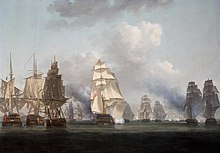
Back Seeschlacht bei Tory Island German Bataille de l'île de Toraigh French Cath Thoraí Irish Battaglia di Tory Island Italian トーリー島の海戦 Japanese Slaget ved Tory Island NB Batalha de Tory Island Portuguese
| Battle of Tory Island | |||||||
|---|---|---|---|---|---|---|---|
| Part of the naval operations during the War of the First Coalition and the Irish Rebellion of 1798 | |||||||
 Battle of Tory island, Nicholas Pocock | |||||||
| |||||||
| Belligerents | |||||||
| Britain | France | ||||||
| Commanders and leaders | |||||||
| Sir John Warren |
Jean Bompart | ||||||
| Strength | |||||||
|
3 ships of the line 5 frigates (OOB) |
1 ship of the line 9 frigates 3,000 soldiers (OOB) | ||||||
| Casualties and losses | |||||||
| 150 killed and wounded |
700 killed and wounded 2,400 captured 1 ship of the line captured 6 frigates captured | ||||||
Battle location | |||||||
The Battle of Tory Island (sometimes called the Battle of Donegal, Battle of Lough Swilly or Warren's Action) was a naval action of the French Revolutionary Wars, fought on 12 October 1798 between French and British squadrons off the northwest coast of County Donegal, then in the Kingdom of Ireland. The last action of the Irish Rebellion of 1798, the Battle of Tory Island ended the final attempt by the French Navy to land substantial numbers of soldiers in Ireland during the war.
The Society of United Irishmen, led by Wolfe Tone, launched an uprising against British rule in Ireland in May 1798. At the request of the rebels, a small French force under General Humbert was landed at Killala, County Mayo, but by early September both this expedition and the rebellion had been defeated. Unaware of Humbert's surrender, the French despatched reinforcements on 16 September. Having missed one invasion force, the Royal Navy was on alert for another, and when the squadron carrying the reinforcements left Brest they were soon spotted. After a long chase, the French were brought to battle in a bay off the rugged County Donegal coast in the west of Ulster, very close to Tory Island. During the action the outnumbered French attempted to escape, but were run down and defeated piecemeal, with the British capturing four ships and scattering the survivors. Over the next fortnight, British frigate patrols scoured the passage back to Brest, capturing three more ships. Of the ten ships in the original French squadron, only two frigates and a schooner reached safety. British losses in the campaign were minimal.
The battle marked the last attempt by the French Navy to launch an invasion of any part of the British Isles. It also ended the last hopes the United Irishmen had of obtaining outside support in their struggle with the British. After the action, Tone was recognised aboard the captured French flagship and arrested. He was brought ashore by the British at Buncrana, on the Inishowen Peninsula. He was later tried for treason, convicted, and committed suicide while in prison in Dublin, hours before he was to be hanged.
© MMXXIII Rich X Search. We shall prevail. All rights reserved. Rich X Search
